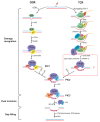Nucleotide excision repair: a versatile and smart toolkit
- PMID: 35975604
- PMCID: PMC9828404
- DOI: 10.3724/abbs.2022054
Nucleotide excision repair: a versatile and smart toolkit
Abstract
Nucleotide excision repair (NER) is a major pathway to deal with bulky adducts induced by various environmental toxins in all cellular organisms. The two sub-pathways of NER, global genome repair (GGR) and transcription-coupled repair (TCR), differ in the damage recognition modes. In this review, we describe the molecular mechanism of NER in mammalian cells, especially the details of damage recognition steps in both sub-pathways. We also introduce new sequencing methods for genome-wide mapping of NER, as well as recent advances about NER in chromatin by these methods. Finally, the roles of NER factors in repairing oxidative damages and resolving R-loops are discussed.
Keywords: damage recognition; global genome repair; nucleotide excision repair; repair mapping; transcription-coupled repair.
Conflict of interest statement
The authors declare that they have no conflict of interest.
Figures


References
-
- De Bont R, van Larebeke N. Endogenous DNA damage in humans: a review of quantitative data. Mutagenesis. . 2004;19:169–185. doi: 10.1093/mutage/geh025. - DOI - PubMed
-
- Kciuk M, Marciniak B, Mojzych M, Kontek R. Focus on UV-induced DNA damage and repair—disease relevance and protective strategies. Int J Mol Sci. . 2020;21:7264. doi: 10.3390/ijms21197264. - DOI - PMC - PubMed
-
- Ewa B, Danuta M-Š. Polycyclic aromatic hydrocarbons and PAH-related DNA adducts. J Appl Genet. 2017, 58: 321–330 - PMC - PubMed
-
- Rushing BR, Selim MI. Aflatoxin B1: a review on metabolism, toxicity, occurrence in food, occupational exposure, and detoxification methods. Food Chem Toxicol. . 2019;124:81–100. doi: 10.1016/j.fct.2018.11.047. - DOI - PubMed
Publication types
MeSH terms
LinkOut - more resources
Full Text Sources

